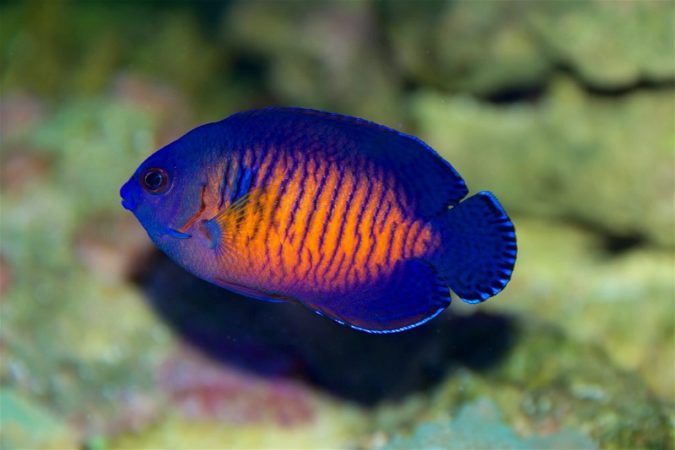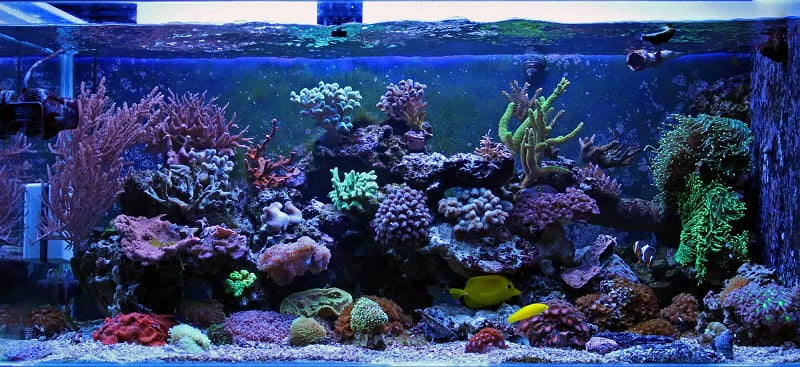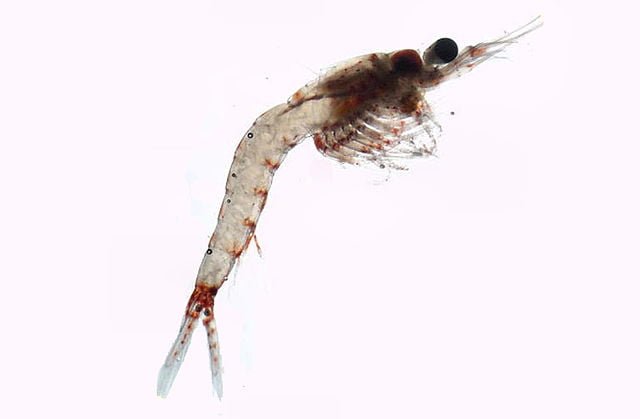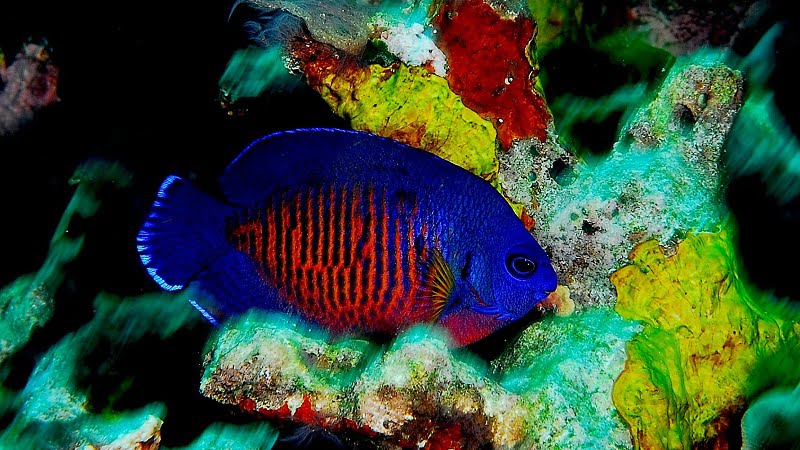Centropyge bispinosus, also known as Coral Beauty Angelfish, Twospined Angelfish, or Dusky Angelfish, is a beautiful coral reef fish.
This species belongs to the Centropyge genus (dwarf angelfish) and is hardy as well as surprisingly easy to care for, making them one of the most common saltwater angelfish for aquarists.
Not only does its stunning appearance attract many fish enthusiasts, but dwarf coral beauty angelfish can also help prevent invasive algae at bay. In captivity, the coral beauty prefers to live in aquariums with plenty of hiding areas, since it is a relatively timid species.
If you are interested in this beautiful dwarf angelfish, keep reading this article. All the necessary information about their origin, appearance, temperament, compatibility, etc., are included to help you manage to keep this coral beauty angelfish in your home aquarium.
Related Articles
- Are Dwarf Angelfish Reef Safe? Top 7 Best Dwarf Angelfish For Reef Tank (with Picture)
- 2 Characteristics About Black Angelfish That You May Not Know
- Where To Buy Altum Angelfish? 3 Big Risks You Have To Face
- Altum Angelfish Care Guide: Lifespan, Size, Tank Size & Setup, Water Parameters, Breeding & More
- Top 15 Best Coral Beauty Angelfish Tank Mates (With Pictures)
- Koran Angelfish: All About Full Size, Reef Safe & More
Species Overview
As compared to other saltwater fish, the Coral Beauty is easy to care for and relatively inexpensive. They are also known as one of the hardiest species of the Centropyge genus.
Here are some important points for identifying and caring for coral beauty angelfish.
- Scientific name: Centropyge bispinosa
- Common names: Twospined Angelfish, Dusky Angelfish
- Genus: Centropyge – Dwarf angelfish
- Family: Pomacanthidae
- Origin: Fiji, Indonesia, Vanuatu
- Distribution: Indo-Pacific, commonly spotted in the Great Barrier Reef
- Temperament: Semi-aggressive (territorially aggressive in the small tank)
- Size: maximum 4 inches
- Tank size: >70 gallons
- Lifespan: An adult can live 10 – 15 years in the wild, but in captivity it is unlikely
- pH: 8.1 – 8.4
- Temperature: 72°F – 80°F (22°C – 27°C)
- Specific gravity: 1.023 – 1.025
- Carbonate hardness (dKH): 8 – 12°
Habitat & Distribution
The coral beauty angelfish inhabits tropical oceans of the Indo-West and Central Pacific, from East Africa, north to Japan, south to Australia, and east to the Tuamoto Islands. The Great Barrier Reef is a common place to find them, and they live mostly in shallow coral reefs.
The coral beauty angelfish hides in crevices of coral reefs and uses them as their shelter. They can live either alone or in small groups and can be found at the depth of 5-45 m.
Coral Beauty Angelfish Size & Appearance
A coral beauty adult can reach a maximum of 4 inches (10.16 cm) in length. Smaller specimens are about 1-1.75 inches (~2.54 – 4.5 cm) in length and can be commonly found in fish stores.
Thus coral beauty dwarf angel has a stunning appearance that can stand out in every aquarium. Their color patterns vary greatly, from almost completely purple to less purple, depending on where they are found. Generally, they have red or orange with thin vertical stripes in a darkish blue.
Particularly, their head, their face, and fins are covered with a purplish-blue coloration. At the base of their pectoral fin, you will see a blue-edged orange-red spot.
In the center of their body, there is an area of orange-red color, which can range from reddish-orange to orange or orange-yellow shades. This area is also characterized by several vertical stripping lines. The stripes appear in thin or thick blue lines with patterns of broken dots and dashes.
As mentioned, their coloration intensity can vary corresponding to their geographical distributions. Thus, the coral beauty angelfish found in the deeper waters are usually pale or yellow color. Meanwhile, shallow-water dwellers display varying degrees of orange and red colors. Additionally, coral beauty from the Philippine variety has a striking blue-red coloration.
In contrast to other angelfish, their coloration does not fade with age. In fact, their colors remain vivid their entire lives.

Behavior & Temperament
Generally, coral beauty angelfish are disease resistant and are relatively peaceful.
They will only display territorial aggression if kept in a small tank where they feel they have to defend their little reef corner.
Thus, it is ideal to keep them in a spacious community aquarium with other fish of a similar size and disposition, and plenty of hiding places.
Although they may occasionally peck at tubeworms or coral polyps, they cause very little harm to invertebrates. Generally, coral beauty has better behavior toward coral reefs than other Centropyge dwarf angels.
Sexual Differences
The Coral Beauty Angelfish are all born females and can be paired up based on size, regardless of color.
In the group of adult coral beauty angelfish, the larger and more dominant specimen will become male while the other smaller ones remain female. Upon the death of the dominant male, the next dominant female in the hierarchy will become a male.
Thus, you can make a pair of coral beauties by purchasing a larger and smaller specimen, and hopefully, they will take on the roles of male and female within a few months, possibly in about two months.
Lifespan Of Coral Beauty
In the wild, coral beauties can live up to 10-15 years. But in captivity, they barely reach that lifespan expectancy of the wild specimens.
However, they can be your beautiful companion for a long period as long as their tank environment can maintain the right parameters and is of good quality.
Clean water and plenty of live rock for your coral beauty angelfish to hide and graze on, along with good tank conditions, will prevent your fish from being stressed, giving them a healthy immune system.
Strong immunity helps your coral beauty angelfish prevent infections, allowing it to live a long and healthy life.
Coral Beauty Angelfish Tank Size
Coral beauty angelfish usually require a pretty large tank because they are active swimmers.
The fish can be stressed even in a 55-gallon tank if they share the tank with algae eaters. When two males are in a tank, they fight one another until one dies.
In order to prevent aggressive behavior toward corals and other fish species, a 70-gallon aquarium is often recommended.
Also, the coral beauty angelfish do not get along with its own species, and with other dwarf angels in the small tanks. Keeping different species of dwarf angels requires an aquarium bigger than 100 gallons, with plenty of hiding spots and food.
The size of a tank should be larger if you plan to breed them as breeding groups. The 120-gallon tank would be great for breeding a male and two females.
Consequently, as the number of members of the group increases, the recommended tank size also increases.
Tank Setup For Coral Beauty
The coral beauty angelfish need a spacious tank for their active swimming activity, and a lot of live rock provide hiding places and growing algae.
Also, the water parameters must be kept stable in the right ranges so that they can thrive and get along with their mates.

Water parameters
The hardy dwarf angle species can survive in normal saltwater conditions. For coral beauty angelfish, one of the most critical things to remember is to keep the water conditions stable. To accomplish this, water changes should be done monthly or weekly.
The best water temperature range for your coral beauty catfish is about 70 – 82°F (21.1 – 27.8° C). For those who want to breed them, the water temperature should be 77°F.
Gravity is also important for coral beauties. Like many dwarf angels, coral beauty does best in the gravity range of 1.023-1.025 SG, thus, ensuring to keep this parameter in range. If the gravity is lower than 1.023, it will negatively affect their long-term health.
Besides, they require a pH of 8.0 – 8.4 with a carbonate hardness (dKH) of 8 – 12°. Having some water currents is also ideal for keeping them healthy because the coral beauty angelfish love to have some fast-flowing water areas in their environment.
Live rock
Coral beauty angelfish prefer a tank with plenty of growing algae and live rock. Thus, adding more live rocks to your tank will make them happy.
Plenty of live rocks will provide more growing algae for your coral beauties to pick and also more shelter places for them to hide when sensing any threatening factors.
Another benefit of having rich live-rock formations in the tank, especially in a reef tank, with coral beauty angelfish is that it can prevent them from nipping on coral reefs. But, in this case, the reef tank must be enormous to get the best result.
Coral reef
Among dwarf angel species, coral beauty angelfish display a more friendly behavior on the coral reefs.
A coral beauty individual may nip at soft corals, LPS and clams if the tank is small and they are not fed well. If they are properly fed and have enough swimming room in the tank, they will often ignore the coral formations.
Here are some corals that can be put in the coral beauties’ tank:
- LPS, SPS, and soft corals (like xenias, tree corals): should be kept with caution because the coral beauty may eat slime layer, causing the coral to close and finally die. But this problem could be minimized in a huge aquarium.
- Leather corals: are safe with the coral beauties but it’s better to keep with monitor as coral nipping will signify that your coral beauties are improperly fed or stressed because of lacking space.
Substrate
Since the coral beauty angelfish spends most of its time circling around rocks and crevices, any substrate will work. However, the fish are likely to prefer a substrate composed of pebbles.
Light source & filter
It is also necessary to have a lighting source for the coral beauty angelfish aquarium since the algae on live rocks need light for active growth.
Dim or blue lighting is ideal for stimulating the spawning of coral beauties while moderate or stronger light intensity is recommended to encourage algae growth.
Moreover, installing a filtration system in their aquarium is important because it can help clean up the tank water, assisting the best water maintenance for your coral beauty angelfish.
Diet & Feeding
Coral beauty angelfish are omnivorous (leaning towards herbivory) and not picky eaters, so keeping them properly fed shouldn’t be difficult. You may notice they pick at algae and other food throughout the day, which actually helps keep nuisance algae under control.
Algae are the main food source of wild coral beauty angelfish. They sometimes eat tiny creatures found in algae. In captivity, they eat mostly algae but may also consume some other proteins.
Therefore, it is important to provide them with a variety of nutritious foods. There are many foods specially designed for fish that primarily feed on algae like coral beauties. Some of the best foods for them are fresh and dried marine algae, foods enriched with spirulina, mysis shrimp, shaved shrimp, and high-quality meaty foods, as well as flakes or pellets designed for fish that enjoy eating algae.
There are also a number of good commercial foods on the market, including Formula II and Angel Formula. You should feed your coral beauty several times each day, even if the natural food source (algae) is present in their tank.
In the aquarium, they can pick on corals and clams if they don’t receive a proper diet or are not fed often enough. In such cases, you can use the veggie clip to place some dried marine seaweed in their tank as an additional food source.

Common Diseases
The coral beauty angelfish can have problems with saltwater fish diseases, like other dwarf angelfish species. These diseases are associated with parasitic and bacterial infections and physical ailments.
- Parasitic diseases:
Like other dwarf angelfish, coral beauty angelfish are susceptible to parasites like Cryptocaryon irritans, which causes marine white spot disease or marine ich.
Another common parasite that infects marine fish species is Amyloodinium ocellatumis, a parasitic skin flagellate. This parasite causes marine velvet, also known as velvet disease, or amyloodiniosis.
- Bacterial infections:
The coral beauty angelfish are also susceptible to bacteria and fungi just like all dwarf angels. An infection caused by bacteria is often a secondary infection as a result of damage caused by parasitic or protozoan diseases.
One of the most concerning bacteria is Vibrio. It causes Dropsy, Popeye, Bleeding, or Red Streaks as the result of internal infections. If your coral beauty is unfortunately infected with this bacterium, it can be rapidly killed within a few days.
The infection typically begins with a back-fin rot, spreads quickly, and eventually kills the fish within two days.
- Physical ailments:
Environmental stressors, such as poor water or tankmates, are often responsible for physical ailments. Poor water conditions can result in fish gasping, not eating, jumping out of the tank, and compromised immunity.
When under stress or being picked on, dwarf angelfish will hover in the upper corner of the tank and can bully the other fish. The problems related to unsuitable tankmates can lead to severe nipped fins and bite wounds.
- Prevention:
It is best to provide your coral beauty angelfish with clean water and plenty of places to hide in order to prevent infections. By attaining a good aquarium environment, you can eliminate the stressor affecting your fish’s immune system, helping them stay healthy.
Performing regular water changes is crucial to lowering the nitrates and ammonia levels. Changing 30% of water content per month, or 15% every two weeks is advisable.
If you have a coral reef tank, water changes should be done 20% every month, 10% every two weeks, or 5% per week.
In addition, keeping up with your water tests will let you know when you need to change the water in your tank.
In order to prevent diseases, you should also quarantine your newly acquired fish for two to three weeks to observe if it has any problems, before introducing it to your main tank.
Coral Beauty Compatibility
This species is territorial with other dwarf angels and with its own kind but is compatible with large angelfish species like Emperor Angelfish or Queen Angelfish.
Captive-bred dwarf angelfish could be housed in a pair or group but with caution. Getting a male and a female to form a pair of coral beauty angelfish is usually the best option.
Besides, you should avoid keeping two males of the same coral beauty species, because they will aggressively fight each other. This marine angelfish can also be kept alone with other suitable fish varieties.
You should carefully select tank mates for your coral beauties because they will sometimes display aggression toward other fish that have the same or smaller sizes.
If the aquarium is spacious enough to provide them with enough swimming room, they will not bother their tankmates. Nevertheless, aquarists often add them last to the tanks just to be safe.
Some other fish species that can become good tankmates for coral beauty angelfish include smaller Clownfish, Yellowtail Blue Damselfish, Mandarin Gobies, Firefish Gobies, and Cardinalfish.
Spawning & Breeding
Coral beauty spawning behaviors
Despite sharing many characteristics with other dwarf angelfish, the spawning of coral beauty angelfish has some differences in the wild.
Belong to the dwarf angel genus, coral beauties are broadcast spawners. They will simultaneously release eggs and sperm at dusk.
However, while many other dwarf angelfish swim to the top level of the water column to spawn, the coral beauty angelfish prefer staying closer to the coral reef regions.
Coral beauty angelfish breeding
Though breeding the coral beauty angelfish is difficult but many breeders have successfully reproduced them. Below are some notes for you if you think of breeding your coral beauties.
- It is crucial to determine the gender of a group of fish before breeding coral beauties. In general, male coral beauties are larger than female ones. In addition, it is possible to tell a male and a female based on their behavior. The male coral beauty is more territorial and acts more aggressively towards other males of the same species.
- Besides, you can try to pair the coral beauties to see if they attack each other. If they don’t attack each other, they are more likely to be a couple.
- Breeding the pair will be easier if you keep the aquarium large, around 70 gallons. Make sure you give them nutritious food periodically.
- In a breeding tank, 77°F is an ideal temperature because, at this temperature, hatching will take place 16 hours after spawning. If the water is cooler, hatching will take longer.
- Since, in the wild, their spawning occurs at lower coral reef areas, it is recommended to have a deeper aquarium.
- Bright and strong lighting should not be used in the aquarium because it will discourage the pair from reproducing. To encourage their spawning, schedule the lighting time to mimic a night-day cycle.
- If you want to simulate the dusk cycle in your aquarium, first turn off half the lights (the brighter ones), then an hour later have the other half (actinics) light go out.
- The female will release eggs after a few weeks or months when the couple mates. Floating eggs will be fertilized by the male in the tank.
- In less than a day, the eggs will hatch, and within two to three days after hatching, they will need microscopic algae for their tiny mouths.
Video: Dwarf Coral Beauty Angel
FAQs
Is coral beauty angelfish reef safe?
Since they are omnivores, they do sometimes nip corals, particularly the soft ones. To begin with, the coral beauty angelfish is not a good choice for a reef tank. However, the coral beauty can share a tank with the coral as long as certain precautions are followed.
Your coral beauty angelfish should be fed a proper diet on a regular schedule to prevent them from eating corals in the tank.
Also, a large tank with many live rock formations and active algae growth will help keep your coral reef safe from the big-eater coral beauty angelfish.
Are coral beauty angelfish hardy?
It is generally easy to care for coral beauty angelfish, especially if they have been captive-bred. Keeping basic living conditions with a nutritious diet can be sufficient to support their health and growth.
How often should I feed my coral beauty?
You should feed your coral beauty angelfish several times per day. This depends on how large your tank size is.
If your tank has a lot of natural algae sources, you should feed them typically 2 to 3 times a day.
If the tank is larger with more algae for them to eat, you should feed them once or twice a day. The food that they can consume in four minutes is adequate for their health.
Conclusion
While coral beauty angelfish are relatively easy to keep, maintaining a successful marine aquarium takes patience and knowledge.
In general, they are hardy, easy to care for, and good eaters. Their diet generally consists of hair algae on live rock and any kind of food they are offered.
Besides, you must ensure that the aquarium mate you choose is healthy and compatible with your coral beauty angelfish. As well, provide this shy fish with plenty of hiding places so it will feel secure and comfortable to join the aquarium activity with their friends.
It is important for you to keep the water clean and the parameters stable and in proper ranges. This is one of the best ways to keep your coral beauties happy, strengthen their immune system, and stay healthy.
References:
https://en.wikipedia.org/wiki/Twospined_angelfish

Annette M. Chaney is an experienced marine biologist with over 20 years of experience as an aquarist and fishkeeper. She started her first aquarium at a young age, filling it with frogs and goldfish obtained from the ten-cent pet store.
Annette grew up caring for and breeding African Cichlids, which led to a hobby in high school that doubled as a profitable means. Attending Reed College gave her time to solidify herself as an accomplished aquarium caretaker with an eye for sales. After that, from 2009 – 2013, she studied at Roger Williams University – one of the most prestigious universities for Aquaculture and Aquarium in USA. She is the founder of AquariumCircle since 2010.
